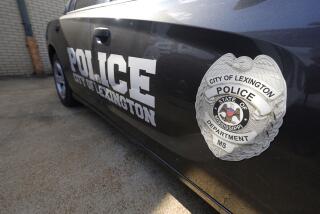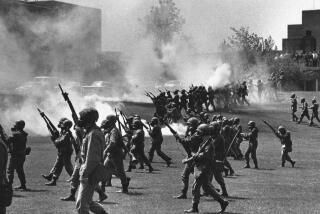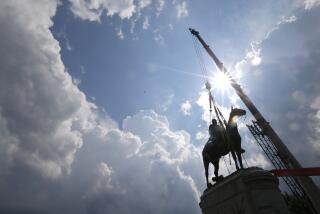Soldiers’ stories echo in Lexington
LEXINGTON, Va. — This pretty little college town in the Shenandoah Valley usually gets no more than a brief mention in history books, belying its status as a major Confederate shrine. No great battles were won or lost here, yet the Civil War movie “Gods and Generals,” which opened last month, begins and ends in Lexington.
Fate has bequeathed the town a notable heritage, fueled in part by two of its institutions: Virginia Military Institute and Washington and Lee University. Notable leaders have been affiliated with both.
As an American interested in my country’s history (although a Northerner by birth and conviction), I’ve returned repeatedly, most recently in December, drawn by its curious tale.
If you see the movie -- I caught it on opening day -- you’ll notice early on a scene depicting Thomas “Stonewall” Jackson, the Confederate general-to-be, as an instructor in 1861 at Virginia Military Institute, now the nation’s oldest state-supported military college. Jackson, the movie’s main character, was accidentally shot and killed by his own troops in 1863 at the Battle of Chancellorsville, and the film’s conclusion depicts his body being returned to Lexington for burial.
Jackson’s link to Lexington would be enough to turn the town into a shrine, but this is only part of its claim to fame.
After the war, Gen. Robert E. Lee, who commanded the Confederate army, became president of what was then called Washington College. Like Jackson, he is buried here. The Confederacy’s two most beloved leaders, who rode together on the battlefield, rest not far from each other in death.
Lee and Jackson are not the only generals honored in Lexington. George C. Marshall, who earned five stars as the U.S. Army chief of staff during World War II, graduated from VMI in 1901. The school’s George C. Marshall Museum details his distinguished career, which earned him the Nobel Peace Prize in 1953.
All this history comes wrapped in a tidy package. When I first visited this town, I was immediately charmed by its beauty. Lexington, which has about 7,000 residents, seems to get prettier every time I return. With inviting inns, a summer theater and beautiful views, it has become a popular weekend getaway destination from Washington, about 3 1/2 hours northeast, and Richmond, about 2 1/2 hours southeast.
Draped across a cluster of tree-shaded hills between the Blue Ridge Mountains and the Alleghenies, Lexington looks as if it had been neatly arranged in the middle of a large, well-tended park. The wide lawns of the two college campuses begin at the edge of the town center, which is decorated in season with baskets of flowers dangling from 18th century-style lampposts. Inviting shops, art galleries and fine cafes and restaurants prove relaxing after the history lesson.
The visitor center at 106 E. Washington St. is the place to begin a history tour; everything is within easy walking distance.
Lexington was founded in 1777 and is named for the pre-Revolutionary War Battle of Lexington, Mass., two years earlier. Nineteenth century Federal-style brick and stone buildings still line streets that Lee and Jackson surely would recognize.
A few steps from the visitor center is the Stonewall Jackson House, a modest structure where he and his second wife, Mary Anna, lived from 1858 until the outset of war in 1861. (His first wife, Elinor, died in childbirth in 1854, a little more than a year after their marriage.) The house contains much of the Jacksons’ furniture and includes such touches as his razor resting on a bedroom nightstand. On one visit, a guide told me that Jackson vowed not to shave until the South won the war. In “Gods and Generals,” Jackson’s beard dangles to his chest.
I’ve heard guides at the house describe his religious fervor, also made evident in the movie. Jackson reportedly was often seen walking about town with his hand held high, presumably deep in prayer. He is said to have viewed every act, even the most mundane, as part of his duty to serve God.
Though Jackson had many talents, teaching apparently wasn’t one of them. Occasionally one of the guides will reveal that, despite Jackson’s military genius, he was tediously dull in the classroom. This explains a scene near the beginning of the film that shows the cadets sitting benumbed after the day’s lesson.
Stonewall Jackson Memorial Cemetery, where Jackson and Mary Anna are buried, is a short walk from the house. His crypt lies beneath a soaring bronze statue of him in uniform. Another statue, this one with his coat whipped by the wind, stands at the end of VMI’s 12-acre parade ground and depicts Jackson as he surveyed the field at Chancellorsville before his death. At its base are the cannons he used to drill students in artillery practice.
VMI, founded in 1839, has about 1,300 students. (Women joined the ranks in 1997.) During the school year, visitors can watch a cadets’ dress parade at 4:15 p.m. Fridays.
During the Civil War, cadets helped train recruits for the Confederate Army. On May 15, 1864, the entire student body engaged Union forces in the Battle of New Market. They helped regular Confederate troops defeat a Union army pushing south to disrupt supply lines and communications in the Shenandoah Valley. Reinforced by the corps of cadets, the Confederates broke the Union line, driving the Northern force back across the north fork of the Shenandoah River. Ten cadets were killed and nearly four dozen wounded.
The site, about 75 miles north of Lexington, is a state historical park. Whatever your sentiments, you cannot help but be touched by the courage of the young men, as I was when I visited the battlefield recently.
The mounted hide of Little Sorrel, Jackson’s favorite horse, stands as if alive not far from VMI’s Cadet Museum. The India-rubber raincoat Jackson wore when fatally wounded is displayed in a case nearby. (Look closely and you can see the bullet hole below the left shoulder.) Elsewhere the museum chronicles the history of VMI with historic paintings, uniforms, mementos of cadets in battle and tributes to other notable graduates.
Overlooking VMI’s parade ground, the George C. Marshall Museum is a tribute to the institute’s most famous graduate. Marshall, who served as secretary of State after his military career, arrived at the university in 1897 poorly prepared academically, but he graduated four years later in the top half of his class. The museum traces his college and professional career with photos and mementos, including the Nobel Peace Prize medallion he was awarded in 1953 for his role in the Marshall Plan, which helped revitalize war-torn Europe.
The museum also presents a 27-minute electric map show depicting the sweep of World War II in Europe and Asia. It’s a fascinating display -- I’ve sat through it three times -- illustrating the challenges Marshall and the Allied forces faced in winning a war on two major fronts.
Lee’s legacy
Today’s Washington and Lee University dates to 1749, when it was founded as the August Academy. It was renamed Washington Academy in 1798 in honor of another famous general, President George Washington, who managed to procure a gift to help the university get back on its feet after a devastating fire.
It was renamed Washington College in 1813. Lee accepted the post as its president after surrendering his army at Appomattox Courthouse in 1865. Four years later, after living in temporary quarters, he moved with his wife, Mary, into the president’s house, which he helped design. The large white-frame home has a wraparound porch built especially for his wife, who was crippled by arthritis. He died in 1870, and the college subsequently added “Lee” to its name.
Down the hill in front is Lee Chapel, a Romanesque brick structure built during Lee’s administration and considered Lexington’s major attraction, drawing throngs in homage or curiosity. Lee and family members are buried in a crypt beneath the chapel. Outside, a plaque at the chapel’s rear marks the burial place of Traveller, Lee’s beloved horse, within a few feet of his master.
In the front of the chapel pews is the famous statue of Lee by sculptor Edward Valentine. Lee is lying on his back, as if sleeping on the field of battle. These tributes seem worthy of a saint, although my Northern eye finds them excessive.
There’s more to Lexington than Civil War history, of course. I especially like Artist in Cahoots, a gallery run by local artists and craftspeople, and Artisans on Washington Street, another fine collection of contemporary and traditional crafts. I bought a Blue Ridge landscape from Cahoots a few years ago that hangs over my desk.
Lexington’s premier restaurant is the Willson-Walker House, which features a contemporary American menu -- Southern-flavored -- in a restored 1820 Classical Revival townhouse. A tempting lunch dish of pulled smoked pork, a staple in rural Virginia, is served with stewed potatoes, collard greens and cornbread ($5.95); it might have been familiar to Lee and Jackson.
My wife, Sandy, and I sometimes choose the Blue Heron Cafe, a cheery little vegetarian restaurant around the corner. It serves organic juices -- I like the raspberry and apple -- and light seasonal specials, such as spicy squash soup, warm herb pasta and crispy mixed salad.
At day’s end you can stay in the historic district at the seven-room, all-suite Alexander Withrow Inn or its sister property, the 16-room McCampbell Inn, across the street. The Withrow was built in 1789, the McCampbell in 1807, and they have been transformed into boutique hotels furnished with period antiques.
But Sandy and I usually stay a little farther afield, about 40 miles west of Lexington at the deluxe 17-room Fort Lewis Lodge, a 3,200-acre retreat of fields and forests ringed by high green ridges. Set far back from the little country roads that ply this part of the state, it is one of the quietest, most serene spots I’ve ever found.
Gorgeous views stretch almost endlessly across hay fields and pastures belonging to a working farm that traces its origins to the Revolutionary War. Lodge buildings, clustered around a millpond, retain the proper look of a frontier farm, attractive and well kept.
After a full day, it’s just the right distance from Lexington and its history.
James T. Yenckel is a travel writer based in Washington, D.C.
More to Read
Sign up for The Wild
We’ll help you find the best places to hike, bike and run, as well as the perfect silent spots for meditation and yoga.
You may occasionally receive promotional content from the Los Angeles Times.






